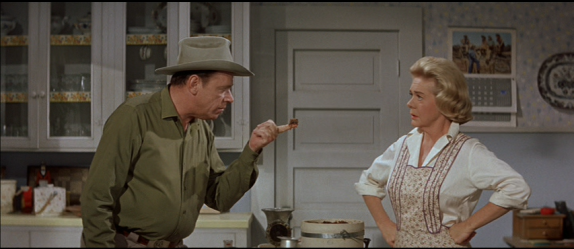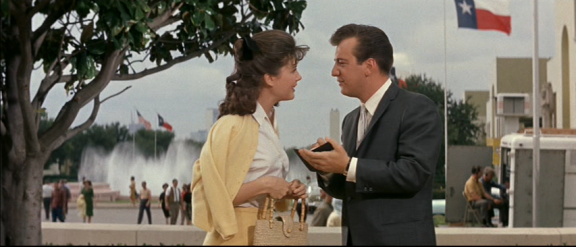
Different city. Different state. Much, much bigger fair. It is Texas we’re talking about, after all. Hollywood has never been one to let a beloved property languish on the shelf, and in 1962 Twentieth Century Fox released its remake of State Fair, hoping to make some more magic out of the Rodgers and Hammerstein musical. The new film had a big budget, a nice wide screen, and a lot more action, so what could possibly go wrong?
Yeah…it didn’t come off so well, but we’ll get to that.

The film opens in Banning, Texas, where Wayne (Pat Boone) is dropping off his girlfriend, Betty Jean (Linda Henrich) in his snazzy race car. Betty Jean is extremely unnerved by Wayne’s love for smoking the competition on the track, but it’s only because she’s worried about him. Wayne assures her he’ll come back bearing a nice, shiny trophy.
Meanwhile, back at the farm, Abel (Tom Ewell) is getting Blue Boy ready to head off to the fair, and he’s anxious for the vet to drop off some tonic because Blue Boy needs all the help he can get. Melissa (Alice Faye) is in the kitchen making her mincemeat. She thinks it’s all right, but Abel sticks his finger in it a few times and tells her it’s too flat. He waits until she’s out of the kitchen before adding more brandy to it. Melissa, meanwhile, adds her own shot of brandy to the mix before hiding the empty bottle.

Margy (Pamela Tiffin) is brooding out on the pier, dipping her toes in the cow pond. She’s bored with her life. Her boyfriend, Harry, would rather wait for new farm equipment than go to the fair. He assures her it’s for them so they can get married, but Margy wants romance.
The Frakes drive all night to Dallas, where they set up house in the trailer park they always stay at. Abel parks himself next to Blue Boy, and just for good measure he sings to him. It’s exceedingly weird and the two farmers standing by make appropriate faces.

Wayne heads for the track, where he races in his qualifying heat. Red (Tap Canutt), his old rival from last year is back and just as contentious, but Wayne has his snazzy Devin kit car, so Red might not want to count his chickens.
Red may have competition in another way. The three qualifiers get kisses from Emily Porter, a beautiful and mysterious woman with legs up to her armpits. Wayne can’t get enough of looking at her, and when he sees her performing “Isn’t It Kinda Fun?” he’s so entranced he walks right up to the stage. Wayne is so gone he paints Emily’s name on the back of his kit car, which makes Mother nervous.

Margy makes a beeline for the midway and the exhibits, where a giant cowboy statue makes pronouncements in a loud, booming voice. Naturally, the fair is being covered by the local TV stations, with dreamboat Jerry Dundee (Bobby Darin) at the center doing step-up interviews. Jerry casts his eye on Margy, and it’s creepy because he’s a classic masher. In spite of herself, Margy is smitten.
And we can’t forget the prized mincemeat and prized Blue Boy, each with their own destinies. The movie doesn’t stray from those important subplots, so it’s not much use going into a lot of detail. Blue Boy gets a blue ribbon, Melissa’s mincemeat wows and inebriates the judges, and everyone goes home happy.

OK. Here’s what I liked about the film.
Pat Boone is either beloved or maligned, and not many people of my generation or later will admit to being a fan of his. As Forrest Whitaker’s immortal Eddie Garlick once said, “A man does not refer to Pat Boone as ‘a beautiful genius’ if things are all right.”

Me, I’ve always been kinda iffy about Pat Boone, especially when he went through his metal phase in the nineties. However, I really like him in State Fair–he brings something cool to the character of Wayne. He’s a goofy farm kid who loves to race cars, and while he’s a little naïve, he’s also cute. And the Rogers and Hammerstein songs nicely suit his voice. It’s all very smooth.
I also liked seeing Alice Faye play Melissa. This was Faye’s big return to movies after being out of them for sixteen years, so it was a big deal at the time. And…she’s Alice Faye. I’ve always liked her because she seems like someone I’d want to be friends with.

What’s nice about her playing Melissa is that she models a healthy married relationship for her children, and it’s not just for show. She really does have a romantic, fun relationship with Abel. At least once she gets him away from Blue Boy, anyway. The two of them kiss on the carousel and banter back and forth, so it’s obvious that they’re really in love.
I also like that the music seems to be integrated into the plot more instead of being mostly show pieces as they were in the 1945 film. It’s very effective for Wayne to belt out “That’s For Me” after meeting Emily because it shows how gobsmacked his character was at that moment. Working the music into the character development is how the movie rolls, and it pretty much succeeds.

It’s also, unfortunately, where the movie fumbles. The biggest problem I have with the 1962 State Fair is that it lacks the innocence of the 1945 movie. “Isn’t It Kinda Fun?” was originally a winsome, flirty little ditty sung around the piano. In the 1962 movie the song is vamped up big time with a steamy Ann-Margret in a tiny skirt and stillettos. As a number it isn’t so bad, but the lyrics ring hollow. It’s hard to believe someone who radiates sex appeal that much is really as innocent as the song she’s singing. Emily is clearly an experienced woman, albeit not necessarily a floozy.
Other songs are just problematic. “Never Say No To A Man,” is sung to Margy by Melissa, and it’s awkwardly painful. For one thing, it assumes too much, namely, that the man in question is worth saying yes to now and then. Errr…not good.

I also felt creeped-out by Bobby Darin’s character. Jerry is a lothario who lays on the butter as a matter of course. When he sings love songs to Margy it’s likely because he wants to know her on a carnal basis, not because he really loves her. Guys like this have always left me cold because their attention span usually only lasts until the next skirt swings by. Margy would have been better off cutting her losses.
Critics weren’t kind to this version of State Fair. Where Bosley Crowther called the 1945 film “average,” he called the 1962 one, “corn.” Clyde Gilmour of MacLean’s called it “stodgy.” Yipe. Audiences agreed, because the film’s profits were dismal, pulling in a minuscule $3.5 million.

State Fair wasn’t quite done, though. A TV series starring Mitch Vogel was attempted but never got picked up. However, the story found new life in a completely natural place for a Rodgers and Hammerstein property…on the stage, where it remains to this day in productions given all over the United States. It goes without saying that it draws more from the 1945 film than the 1962 reboot, which, despite a lot of missteps, has its moments.
Okay, so not every fair goes swimmingly. Sometimes, though, it can change your life, but we’ll get into that tomorrow. Thanks for reading, all…
State Fair is available on DVD from Amazon.

I’ve tried a couple of times to get through the 1962 version, if only for the sake of my beloved Alice Faye, but have not been able to manage. On the other hand, the 1945 film is a favourite and the 1933 impressed me greatly. I can no longer read Phil Strong’s novel because it was a second-hand copy when I bought it years ago and musty even then. It is a story that is worth telling, but only if it is told well.
LikeLiked by 2 people
It is–it’s so charming and unique. I can’t blame you about the 1962 version. What were they thinking? 🙂
LikeLiked by 1 person
Fun review, Rebecca!
I’ve never seen any version of State Fair, but from your description, I might enjoy the 1960’s version.
LikeLike